Photo by Possessed Photography on Unsplash
Intro
The writing style of ChatGPT can be quite specific and may not be suitable for all types of audience. Sometimes, it can feel repetitive or complex. The good news is, with the right approach, you can easily tame the beast and make ChatGPT work for you. Today, we will dive into a case study and uncover the secrets to unlocking ChatGPT’s true potential. The inspiration for this post came from Rob Lennon’s Twitter thread on ChatGPT’s writing style. Make sure to check it out! I extended it to fit my personal needs and decided to share with the world!
General remarks
There are a few things that I would like to outline before we head into the section with examples:
- It’s important to be clear and specific when including style guidelines in the prompt. We should attach them at the beginning of the prompt.
- The styling guidelines will be written out in brackets, and they will begin with: Writing style guideline:. However, you can try to use different phrases in order to change the output of the model. You could also try passing the guide in different formats, e.g. JSON.
- We will try to answer a question: How to define yearly goals effectively? For the purpose of the experiment, we will start a new conversation for each style.
- ChatGPT needs to be repeated the guidelines from time to time as it tends to drift back to its normal writing style. This is why I recommend adding the styling guide phrase before each prompt.
- Beware of using too many guidelines for short prompts, as ChatGPT will take it too literally for answers that are short. From my experience, the rule of thumb is to make it proportional to the length of the generated output. However, you need to find your sweet spot for this.
Writing Styles
1. Default style
First, let’s see the output without any style guiding.
Prompt:
How to define yearly goals effectively?
Answer:
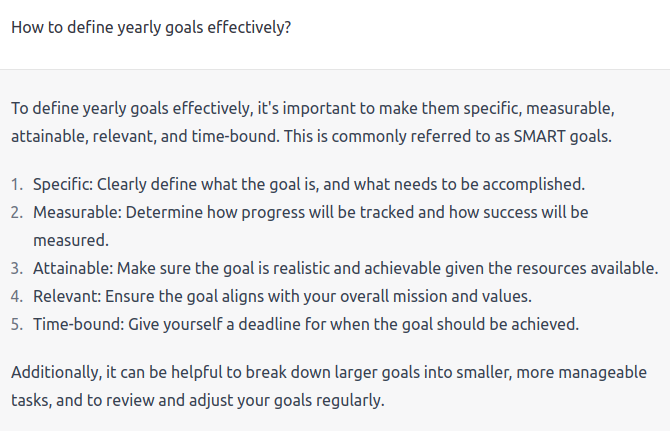 Summary: ChatGPT advises us to follow SMART goals framework. It sounds reasonable, however the advice is very general.
Summary: ChatGPT advises us to follow SMART goals framework. It sounds reasonable, however the advice is very general.
2. Output formatting
Problems:
- ChatGPT often produces responses that lack proper formatting. This makes it painful to read and understand.
- Sometimes there can be specific constraints to the output, e.g. character limit, number of key arguments. We can clearly see that the first output would exceed the Twitter character limit (280 characters). Solution: Define the output format in your styling guide. Examples:
- A single Tweet composed of bullet points and without hashtags.
Prompt:
[Writing style guideline: Generate a single Tweet with a hook and no hashtags. 280 character limit. Organize information using bullet points.]
How to define yearly goals effectively?
Answer:
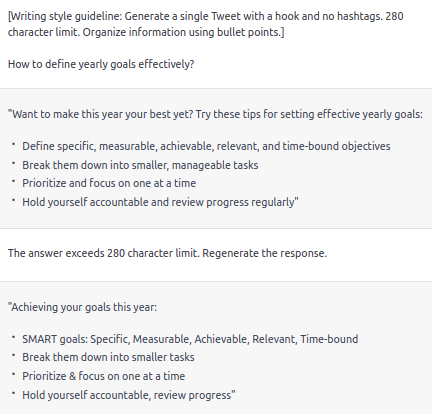 Summary: The response wasn't spot on — it surpassed the maximum number of characters allowed in a single Tweet.However, with additional iteration, the output was valid.
Summary: The response wasn't spot on — it surpassed the maximum number of characters allowed in a single Tweet.However, with additional iteration, the output was valid. - Twitter thread discussing each advice in a single part of it.
Prompt:
[Writing style guideline: Generate a Twitter thread with a punchy hook and no hashtags. Each part of the thread needs to present a single argument.]
How to define yearly goals effectively?
Answer:
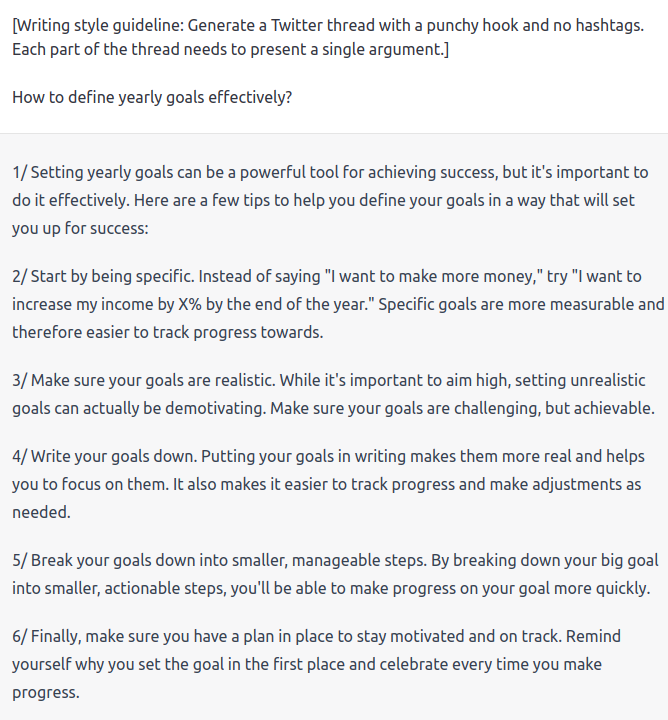 Summary: The answer is correct. We didn’t get the punchiest hook of all time, but for now we are focusing only on the output formatting, so I take it as a victory!
Summary: The answer is correct. We didn’t get the punchiest hook of all time, but for now we are focusing only on the output formatting, so I take it as a victory! - Advice formatted as a Medium article
Prompt:
[Writing style guideline: Generate a Medium article. Use headings, subheadings, bullet points and italics to organize the information.]
How to define yearly goals effectively?
Answer:

 Summary: The output looks good. We can see the use of heading, subheadings and bullet points. I think we can also mark the italics part as done — we can see the parts with apostrophes that we could change to italics on Medium.
Summary: The output looks good. We can see the use of heading, subheadings and bullet points. I think we can also mark the italics part as done — we can see the parts with apostrophes that we could change to italics on Medium.
3. Removing the Pre-Text and Post-Text
Problem: ChatGPT often generates unnecessary introduction and conclusion before the main part of the response.
Solution: With this style guide, you can explicitly tell ChatGPT to dump these parts.
Prompt:
[Writing style guideline: Return only the part with the list of points.]
How to define yearly goals effectively?
Answer:
 Summary: This might not be the best example to use this technique, but you might find it useful in other situations, e.g. code generation.
Summary: This might not be the best example to use this technique, but you might find it useful in other situations, e.g. code generation.
4. Talk to me as I were 5th grader
Problem: The outputs of ChatGPT can consist of long sentences and jargon, especially when we ask it to talk about complex ideas. Sometimes this is unnecessary.
Solution: We can bias ChatGPT to output shorter sentences and simple outputs.
Prompt:
[Writing style guideline: Write at a 5th grade level. Use clear and simple language, even when explaining complex topics. Bias toward short sentences. Avoid jargon and acronyms]
How to define yearly goals effectively?
Answer:
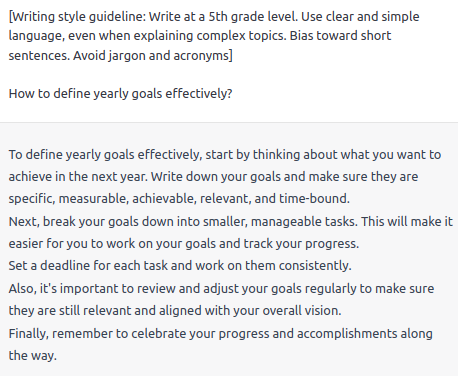 Summary: This looks like a quick, easily digestible version of the output from “Medium article”. I like it!
Summary: This looks like a quick, easily digestible version of the output from “Medium article”. I like it!
5. Executive-level summary
Problem: Sometimes, we have to write something very short but informative. The default style of ChatGPT might not meet those expectations.
Solution: Executive-level summary — it is similar to the 5th grader style (YIKES), but here we are asking to make the information as “dense” as possible.
Prompt:
[Writing style guideline: Write as you were making a summary for a CEO of a big company, who has very little time. Contain as much information as possible with as little text as possible. Use clear wording.]
How to define yearly goals effectively?
Answer:
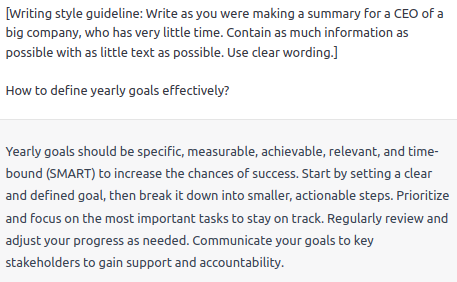 Summary: To be honest, I prefer this style more than the 5th grader style. We reduced the output length without losing much information. You can also try adding a request to generate actionable takeaways if you want to get even more concrete.
Summary: To be honest, I prefer this style more than the 5th grader style. We reduced the output length without losing much information. You can also try adding a request to generate actionable takeaways if you want to get even more concrete.
6. Writing to a friend
Problem: If we would like to use ChatGPT to answer an e-mail to a colleague or respond to a message in a friendly manner, we wouldn’t like to use the wordy default style.
Solution: Let’s ask ChatGPT to use more relatable and conversational style!
Prompt:
[Writing style guideline: Write in a conversational, relatable style as if you were explaining something to a friend. Use natural language and phrasing that a real person would use in everyday conversation.]
How to define yearly goals effectively?
Answer:
 Summary: The output is less “dry” than previously. This is a great style if you want to make a connection with the audience / person receiving the message.
Summary: The output is less “dry” than previously. This is a great style if you want to make a connection with the audience / person receiving the message.
7. Marketing speech
Problem: You may want to use ChatGPT to help you advertise something. If so, we definitely need to make the writing style more pitchy!
Solution: Let’s make ChatGPT imagine it is an expert in marketing!
Prompt:
[Writing style guideline: Imagine you are a marketing expert. Write as a master of brevity would. Use figurative language. Frequently use short, pitchy sentences that pack a punch.]
How to define yearly goals effectively?
Answer:
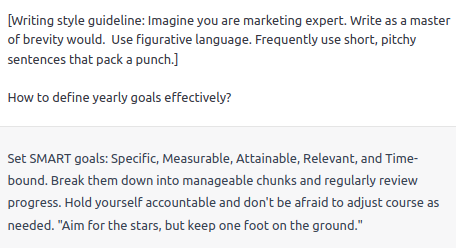 Summary: I am pretty impressed! The output even contains a motivational quote straight from Nike’s commercial 😉.
Summary: I am pretty impressed! The output even contains a motivational quote straight from Nike’s commercial 😉.
8. Academic style
Problem: We may want to make the output even more sophisticated than in the default style.
Solution: Asking ChatGPT to use academic tone but stay clear. Remember that the outputs of Large Language Models may contain false information (wrote an article about here), so it is very important to double check the outputs if we want to use academic style.
Prompt:
[Writing style guideline: Use a formal and academic tone paired with sophisticated vocabulary and grammar. Provide a thorough and in-depth analysis of the subject matter. Explain complex scientific concepts in a clear and accessible way. Use examples from a variety of fields, such as psychology and cognitive science. Present counter-arguments and dissenting opinions in a balanced and objective way.]
How to define yearly goals effectively?
Answer:
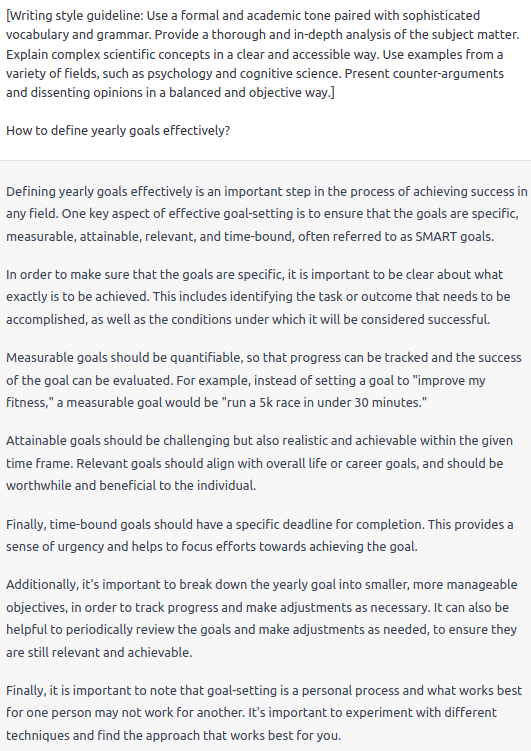 Summary: We can see a more formal tone in this answer, so we can claim a small victory. We can also see some attempts to present counter-arguments. However, there are no examples from psychology or cognitive science.
Summary: We can see a more formal tone in this answer, so we can claim a small victory. We can also see some attempts to present counter-arguments. However, there are no examples from psychology or cognitive science.
9. Becoming a storyteller
Problem: If you want to tell a story, then a default style of ChatGPT is not for you.
Solution: Let’s tell ChatGPT to use language constructs typical for a copywriter (like analogies and metaphors) and make it a bit more entertaining.
Prompt:
[Writing style guideline: Imagine you are a professional storyteller. Make use of persuasive tone, making use of rhetorical questions, and storytelling to engage readers. Use metaphors, analogies and other literary devices to make points more relatable and memorable. Write in a way that is both informative and entertaining.]
How to define yearly goals effectively?
Answer:
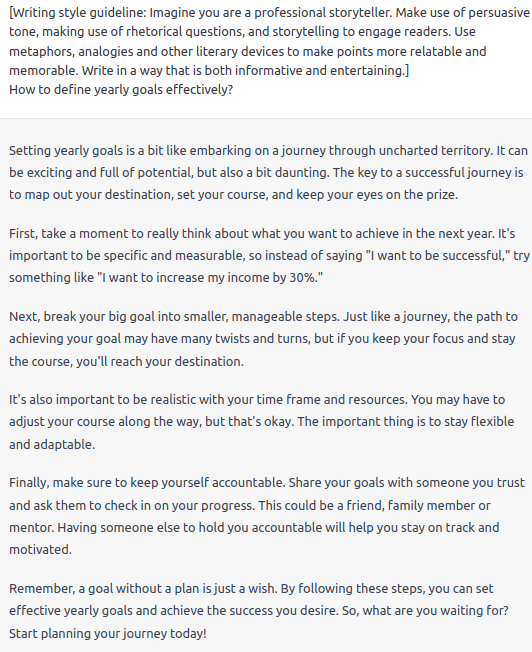 Summary: Wow, I really like this style! We can see that the style is a lot more vivid and persuasive than before. The key to this output was to tell ChatGPT to imagine being a professional storyteller.
Summary: Wow, I really like this style! We can see that the style is a lot more vivid and persuasive than before. The key to this output was to tell ChatGPT to imagine being a professional storyteller.
10. Imagine being a writer X
Problem: We may want to use the style of a specific writer without defining it explicitly.
Solution: Tell ChatGPT to imagine being that writer!
Prompt:
[Writing style guideline: Writing style guideline: Imagine being Ernest Hemingway. Your writing style should be the same as his.]
How to define yearly goals effectively?
Answer:
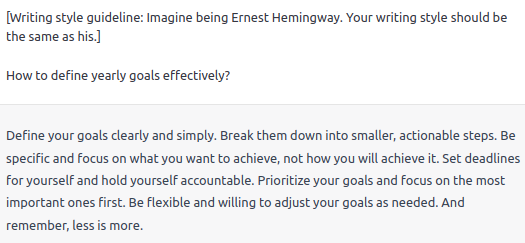 Summary: The output seems fairly similar to Hemingway’s style, I’ll take it!
Summary: The output seems fairly similar to Hemingway’s style, I’ll take it!
11. Bonus style: Make this a Python code!
Note: This style is just an experiment made for fun, so don’t take it seriously! Here, I want to show, how you can ask ChatGPT something very abstract and still get a somewhat decent response. The answers can vary depending on the seed!
Problem: It is hard to present real-world concepts as a code.
Solution: Let’s make ChatGPT do that!
Prompt:
[Writing style guideline: You are trying to describe any real world concept using Python code. You need to use only code.]
How to define yearly goals effectively?
Answer:
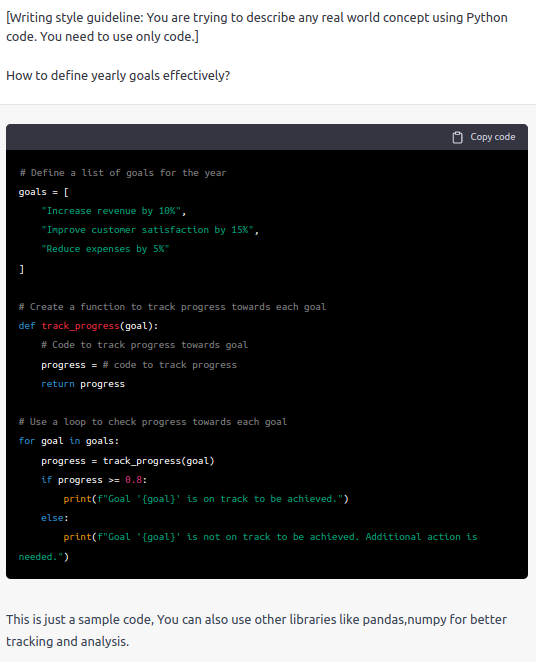 Summary: Now you just need to add the code to track the progress and your goals will become a reality!
Summary: Now you just need to add the code to track the progress and your goals will become a reality!
Conclusion
In this article, we explored 10 strategies to alter ChatGPT’s writing style, with the aim of making it more suitable for different types of audiences.

